One might be surprised to learn that there are actually quite a few different species of water snakes in Illinois. Just as well, there are many snakes that are technically not water snakes that enjoy congregating near Illinois lakes and streams. Let’s take a look at what these snakes are, and what the most snake-infested lakes in Illinois are like.
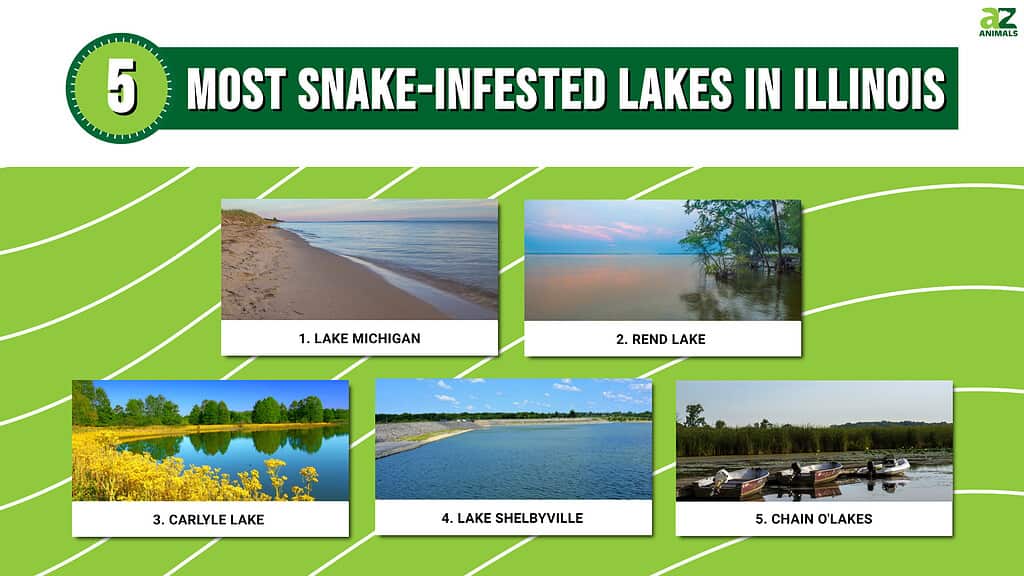
Are There Water Snakes in Illinois?
Water snakes are a very common sight around the lakes and rivers of Illinois. These snakes have a significant ecological impact on the state and are well-suited to watery habitats.
Northern Water Snake
The Northern Water Snake (also known as Nerodia sipedon) is one of the most prevalent water snakes in Illinois. This species inhabits a broad range of aquatic environments throughout the state, including lakes, ponds, rivers, and marshes. The powerful structure of Northern Water snakes is well-recognized and they often reach lengths of two to four feet. They resemble venomous snakes in appearance and have bodies that are dark brown or grey with pronounced black crossbands. They contribute significantly to the state’s aquatic ecosystems and are not dangerous to humans.
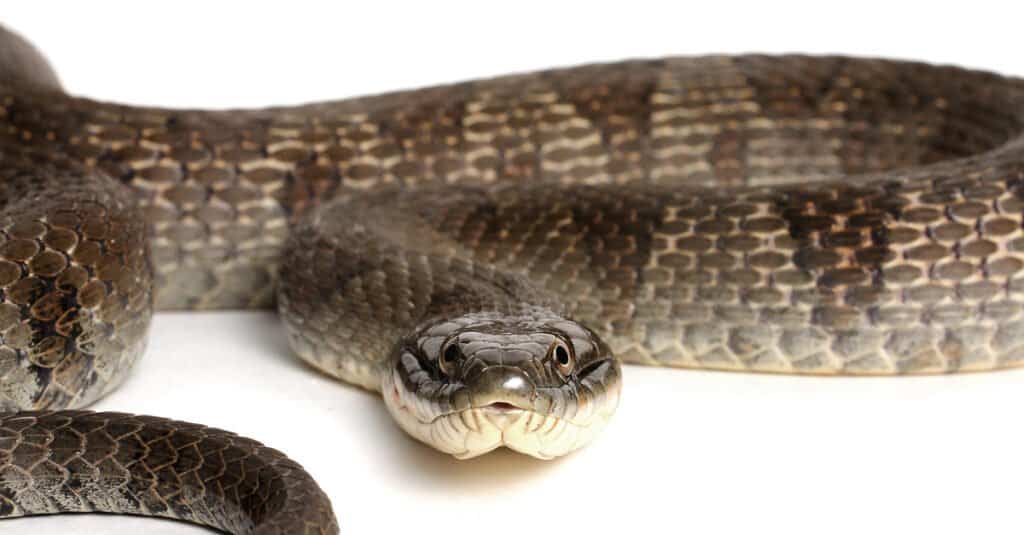
Northern Water Snakes (pictured) might be spooky, but they are harmless and great for the environment.
©Michiel de Wit/Shutterstock.com
Eastern Massasauga Rattlesnake
The Eastern Massasauga Rattlesnake (also known as Sistrurus catenatus catenatus) is another species that can be found in Illinois. The Eastern Massasauga, despite its name, is a small, shy snake that is rarely seen by humans. It lives in wetlands including marshes, swamps, and the banks of rivers and lakes. When confronted, this venomous snake’s tail makes a characteristic rattling noise that it uses as a warning signal. Illinois classifies the Eastern Massasauga as an endangered species and measures are being taken to safeguard its surviving populations and their habitats.
Copperbelly Water Snake
The Copperbelly Water Snake (also known as Nerodia erythrogaster neglecta), which is mostly found in southern Illinois, is a state-endangered species of water snake. This snake’s distinctive reddish-orange belly sets it apart from other water snake species and also gave rise to its name. The backwaters of rivers, marshes, and slowly flowing streams are preferred habitats for Copperbelly Water Snakes. This species is crucial for maintaining the balance of Illinois’ wetland ecosystems and for managing populations of tiny aquatic species like fish and amphibians.
Eastern Hognose Snake
The Eastern Hognose Snake (also known as Heterodon platirhinos) may be found across Illinois, especially in wetlands. These unusual snakes are distinguished by their snouts, which are pointed upward and are used for digging and burrowing. Grasslands, woodlands, and wetlands are just a few of the diverse environments in that Eastern Hognose Snakes can be found. They are harmless and mostly eat toads, frogs, and small animals despite their fearsome look and bluffing habit.
The maintenance of healthy aquatic habitats in Illinois depends on the existence of water snakes. They support the overall ecological balance by assisting in the management of small animal populations, including those of fish, frogs, and rodents. Water snakes contribute to the complex web of life in Illinois’ natural ecosystems by acting as food for larger predators including birds of prey and larger snake species.
It is crucial to remember that while the majority of water snakes are non-venomous and often aim to avoid human contact, interactions with them are usually safe. However, it is best to give a water snake some room and keep your distance if you come across one. Snakes are an essential component of Illinois’ unique fauna and should be valued as such.
Eastern Garter Snake
In Illinois, lakes and their surroundings are often home to the non-venomous Eastern Garter Snake (also known as Thamnophis sirtalis sirtalis). These snakes are distinguished by their distinctive color and broad stripes that can range in hue from green to brown to black. They are suitable for the many settings around Illinois lakes because they are flexible and may grow in a number of habitats, such as woods, grasslands, and wetlands. As predators that eat insects, snails, and small rodents, Eastern Garter Snakes perform a crucial ecological function. They support the preservation of the equilibrium within the lake environment by regulating the numbers of certain prey species.
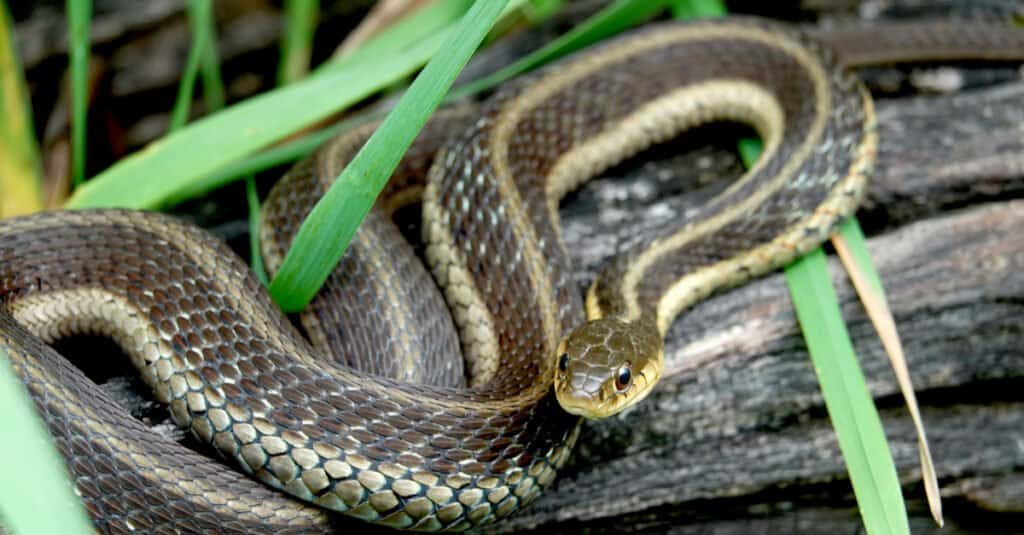
Eastern Garter Snakes (pictured) do a great job of tolerating cold winters in Illinois.
©Erik Agar/Shutterstock.com
The Most Snake-Infested Lakes in Illinois
It’s worth noting that “snake-infested” is a little bit of an embellishment. All of these lakes have snake populations in and around the water, but none of them are currently dealing with excessive populations or infestations that could be dangerous to swimmers.
Snakes, particularly those that can be found around the following lakes in Illinois, are crucial to the ecology. They are regarded as keystone species because of the considerable influence they have on the ecosystem’s general composition and functionality. Snakes aid in the population management of tiny animals, preventing imbalances and unnaturally intense competition within the environment. This in turn improves the stability and general health of the surrounding ecosystem.
Just as well, bigger snake species and other predators like birds of prey eat snakes as food. They are an essential link in the food chain and help the ecosystem’s energy flow. By eating prey and releasing nutrients into the soil through their excrement, snakes contribute to the cycle of nutrients and further improve the local ecosystem.
1. Lake Michigan
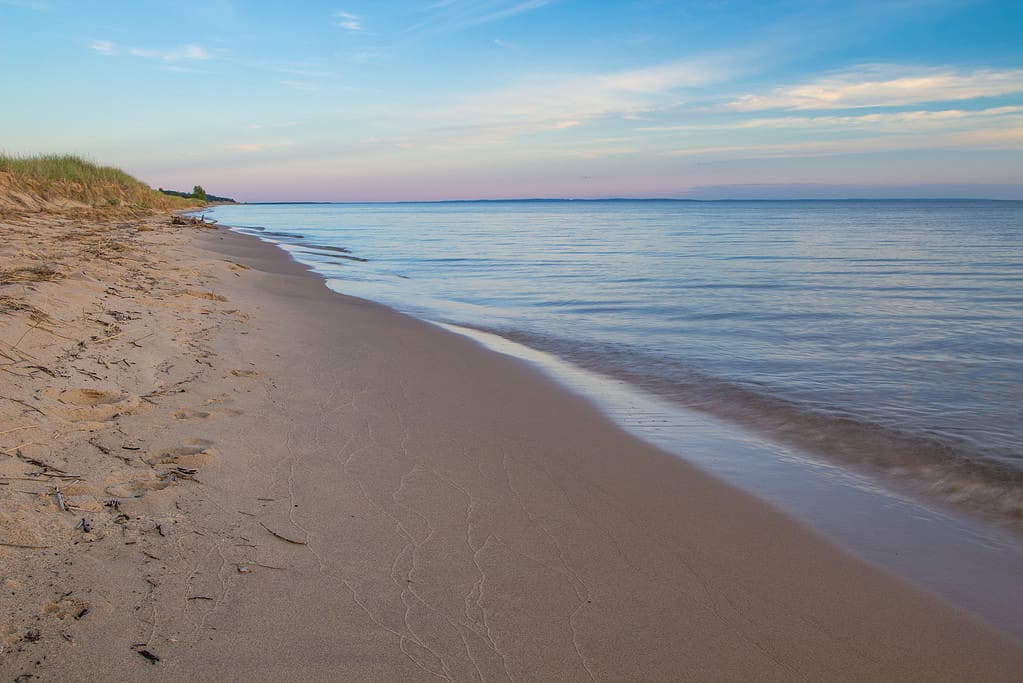
Lake Michigan (pictured) is the third-largest lake in the United States.
©iStock.com/ehrlif
One of North America’s Great Lakes, Lake Michigan lies largely in the state of Michigan but also shares borders with Illinois, Indiana, and Wisconsin. By both volume and surface area, it is the second-largest of the Great Lakes. With its enormous freshwater area, Lake Michigan supports a rich and varied ecology that includes various snake species that live in the areas around it.
Even though the snake population in Lake Michigan is not particularly large, there are several snake species there. One such is the non-venomous Fox snake (also known as Pantherophis vulpinus), which inhabits the nearby ponds, meadows, and woodlands. By regulating populations of tiny rodents and other small animals, these snakes contribute to the preservation of the local ecosystem’s equilibrium.
The Eastern Massasauga Rattlesnake is another type of snake that inhabits the regions near Lake Michigan. Swamps and marshes are preferred habitats for this venomous snake. Despite having venom, the Eastern Massasauga Rattlesnake is shy and non-aggressive and it often stays away from people. It improves the local environment by regulating small animal numbers and preserving a healthy predator-prey relationship.
2. Rend Lake
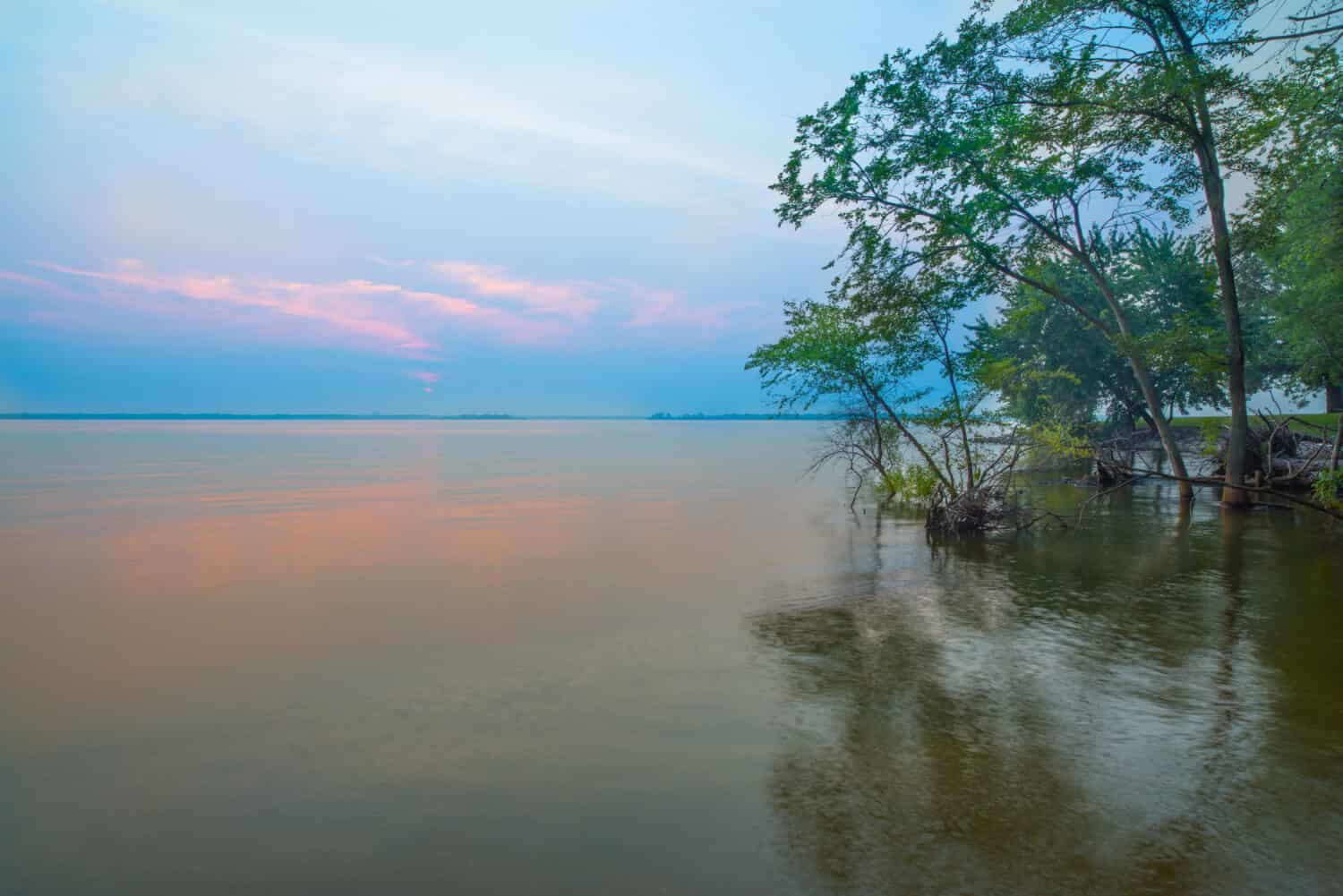
Snakes around Rend Lake are crucial for keeping the environment balanced.
Image: Patrick Jennings, Shutterstock
©Patrick Jennings/Shutterstock.com
A man-made reservoir with a surface area of around 18,900 acres, Rend Lake is situated in southern Illinois and provides a variety of recreational opportunities, such as fishing, boating, and animal observation. The verdant forests, marshes, and wetlands that surround this lovely lake offer a variety of habitats for different animals, including snakes.
Numerous snake species are present close to Rend Lake and contribute to the harmony and efficiency of the regional environment. One such snake is the non-venomous Northern Water Snake that thrives in watery settings. These snakes are essential to maintaining a healthy environment in the lake by managing populations of tiny aquatic species including fish, frogs, and amphibians.
The Copperbelly Water Snake, another snake species present in the region Rend Lake sits, is a threatened species in Illinois. Wetland settings like marshes and swamps are where these snakes may be found most often. The reddish-orange belly of Copperbelly Water Snakes sets them apart from other water snake species. Their existence in the area of Rend Lake is crucial because they help to regulate fish and amphibian populations, which in turn affects the general biological balance of the lake and the marshes around.
3. Carlyle Lake
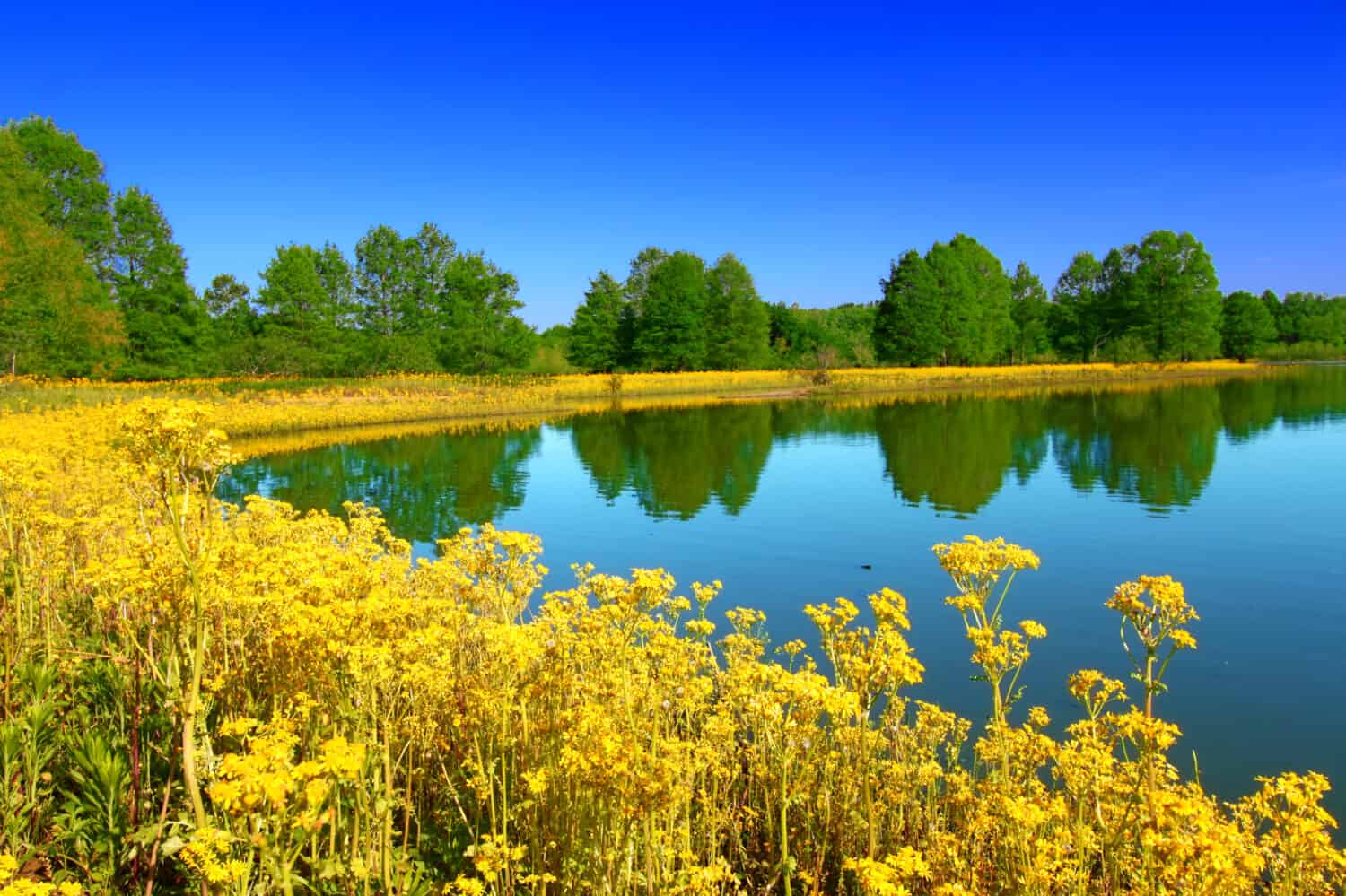
Eastern garter snakes are among the snakes found in the Carlyle Lake ecosystem.
Image: Jason Patrick Ross, Shutterstock
©Jason Patrick Ross/Shutterstock.com
Southwest Illinois’s Carlyle Lake is a large reservoir with a total area of around 26,000 acres. It was built by the U.S. Army Corps of Engineers and is used for leisure, water supply, and flood control, among other things. Various ecosystems, including woods, wetlands, and marshes, surround Carlyle Lake, creating a favorable setting for a variety of animal species, including snakes.
Numerous snake species may be found close to Carlyle Lake, which helps the area’s ecology operate and maintain an ecological balance. The Eastern Garter Snake, a non-venomous species that adapts well to both aquatic and terrestrial settings, is one famous species of snake that lives in Carlyle Lake. These snakes are essential in maintaining a healthy ecology in the lake and its adjacent ecosystems by managing populations of tiny creatures including frogs, toads, and small fish.
The Eastern Massasauga Rattlesnake is a different type of snake that lives in the region. Marshes and swamps are the main habitats of the Eastern Massasauga. By consuming small animals, this snake helps controls their populations and aids in the ecological harmony of Carlyle Lake and the surrounding area.
4. Lake Shelbyville
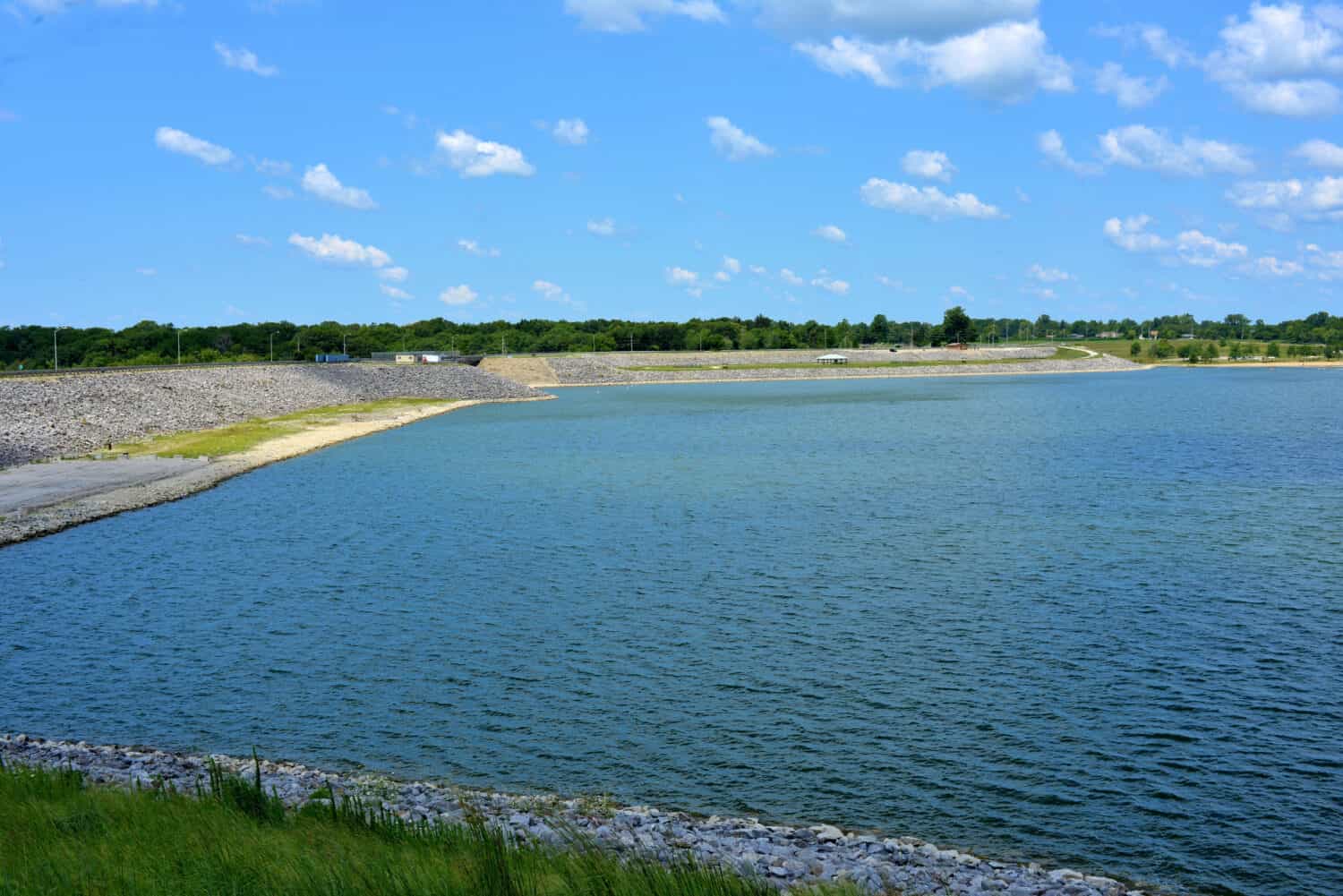
Lake Shelbyville was created by damming the Kaskaskia River.
Image: dvande, Shutterstock
©dvande/Shutterstock.com
Central Illinois’s Lake Shelbyville is a reservoir with a total area of around 11,000 acres. It was built by damming the Kaskaskia River and is a great location for outdoor pursuits like boating, fishing, and animal watching. A variety of animals, including snakes, have found a variety of habitats in the area’s woods, ponds, and grasslands.
Several different snake species may be found in the regions surrounding Lake Shelbyville, despite the fact that the lake itself is not well recognized for having a sizable snake population. One such species is the Eastern Massasauga Rattlesnake (Are we starting to see a theme here?), which is typically found in wetland regions like marshes and swamps. By regulating small animal populations and assisting in the maintenance of a balanced predator-prey dynamic, it benefits the local ecology.
The Northern Water Snake is another type of snake that can be found nearby or in the lake itself. These non-venomous snakes can be found in lakes, ponds, rivers, and marshes because they are well suited to aquatic habitats. By regulating populations of tiny aquatic species like fish and amphibians, they perform a crucial function in the environment.
5. Chain O’Lakes

Chain O’Lakes is a network of connected lakes and rivers spanning over 7,000 acres.
Image: Martha Marks, Shutterstock
©Martha Marks/Shutterstock.com
Northeastern Illinois’ Chain O’Lakes is made up of a network of connected lakes and rivers that cover more than 7,000 acres and is a well-known leisure destination. There are options for boating, fishing, and other water sports in this gorgeous area. Numerous snake species may thrive in the various ecosystems, such as wetlands, marshes, and woods, that surround the Chain O’Lakes.
A few different snake species may be found in and around Chain O’Lakes. The Northern Water Snake is one of these species. By managing populations of tiny aquatic creatures like fish, frogs, and amphibians, these snakes serve a crucial role in maintaining the balance of the lake and the wetland ecosystems that surround it.
Another snake species that is frequently seen in the Chain O’Lakes area is the Eastern Garter Snake. These versatile non-venomous snakes live in a range of environments, such as marshes, meadows, and wooded regions. By consuming insects, snails, and small rodents, Eastern Garter Snakes serve to keep the local food web in balance.
The Eastern Fox Snake is a different species of snake that could inhabit the Chain O’Lakes region. These venomless snakes are well recognized for their climbing skills and inhabit a variety of environments, such as marshes, grasslands, and woodlands.
Summary of The Most Snake-Infested Lakes in Illinois
| # | Lakes | Snakes Found |
|---|---|---|
| 1 | Lake Michigan | Fox Snake, Eastern Massasauga Rattlesnake |
| 2 | Rend Lake | Northern Water Snake, Copperbelly Water Snake |
| 3 | Carlyle Lake | Common Garter Snake, Eastern Massasauga Rattlesnake |
| 4 | Lake Shelbyville | Eastern Massasauga Rattlesnake, Northern Water Snake |
| 5 | Chain O’Lakes | Northern Water Snake, Fox Snake, Eastern Garter Snake |
Other Animals Found Near Lakes In Illinois
In addition to snakes, there are numerous species that live in the lakes and waterways of Illinois. These creatures support the local ecosystems’ general health and ecological variety.
Birds
Numerous birds of prey, such as bald eagles, ospreys, and different hawks, are drawn to the lakes in Illinois. These predators use the lakes as hunting grounds, consuming fish and small animals. This helps control populations and preserve the ecosystem’s balance.
A broad variety of waterfowl species, such as ducks, geese, and swans, are drawn to lakes in Illinois. Among the frequent waterfowl species that may be seen in and near Illinois lakes are mallards, Canadian geese, and tundra swans. These birds add to the landscape’s natural beauty and depend on the lakes for eating, breeding, and resting when migrating.
Fish
A variety of fish species live in Illinois lakes. In fact, the diverse species of fish found in Illinois make it a hotspot for fishing. Largemouth and smallmouth bass, walleye, northern pike, and a variety of panfish including bluegill and crappie are all common game fish found in Illinois. Anglers come from near and far to catch these fish because they are important members of the aquatic food chain.
Amphibians
There is also a rich population of amphibians that is supported in Illinois by lakes and marshes. The shoreline is home to frogs including bullfrogs, chorus frogs, and green frogs, while the nearby terrestrial regions are inhabited by salamanders like the eastern tiger salamander. Amphibians play a role in pest management and are significant environmental health indicators.
Reptiles
A few different types of reptiles may be found close to Illinois lakes in addition to snakes. In the Illinois region, it’s common to see many different species of turtles close to lakes. You can see painted turtles, snapping turtles, and softshell turtles swimming in the lake or laying in the sun on logs. These reptiles contribute to overall biodiversity and are significant elements of the neighborhood environment.
Mammals
Several different animals can be found in Illinois’ lakeside settings. White-tailed deer, raccoons, opossums, beavers, and muskrats are examples of common species. The lakes and the surroundings around them provide these creatures with refuge, food, and water.
Aquatic Invertebrates
Numerous aquatic invertebrates live in Illinois lakes and include insects, crustaceans, and mollusks. Some examples of these Illinois-native creatures include mayflies, dragonflies, crayfish, and freshwater mussels. These invertebrates perform critical roles in nutrient cycling, and water quality, and serve as key food sources for a variety of other creatures.
The photo featured at the top of this post is © Mike Wilhelm/Shutterstock.com
Discover the "Monster" Snake 5X Bigger than an Anaconda
Every day A-Z Animals sends out some of the most incredible facts in the world from our free newsletter. Want to discover the 10 most beautiful snakes in the world, a "snake island" where you're never more than 3 feet from danger, or a "monster" snake 5X larger than an anaconda? Then sign up right now and you'll start receiving our daily newsletter absolutely free.
Thank you for reading! Have some feedback for us? Contact the AZ Animals editorial team.







